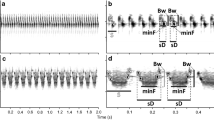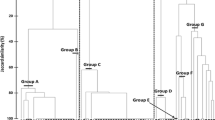Abstract
Species in similar habitats are often similar in morphology or behaviour, attributed to adaptation to similar environmental selection pressures, sometimes mediated by competitive interactions. For passerine songs, similarity of phenotype in identical habitats and character displacement have been documented, the former due to adaptation to the acoustics of the habitat, and the latter due to competition for acoustic space among species. If these phenomena are widespread, they should lead to community convergence of bird songs. Here, we test if passerine communities in similar habitats converge in song attributes or in acoustic differentiation among species. We compared the songs of European and North American Mediterranean climate passerine communities in open and closed habitats. Song frequency varied across different habitats but not continents. This was independent of both phylogeny and body size, indicating community convergence due to acoustic adaptation, rather than species sorting or similarity as a by-product of another type of ecological convergence. We found little evidence for regular spacing in song features among species, as would be expected if acoustic competition shapes within-community structure. However, for one of five song components, the open habitat communities showed a similar distribution of phenotypes on each continent. The proportion of interspecific variation in song explained by these effects was small. The fact that songs are complex signals that vary in many dimensions may explain why competition for acoustic space seems to be of small importance in structuring songs in these passerine communities.


Similar content being viewed by others
References
Alström P, Ericson PGP, Olsson U, Sundberg P (2006) Phylogeny and classification of the avian superfamily Sylvioidea. Mol Phylogenet Evol 38:381–397
Barhoum DN, Burns KJ (2002) Phylogenetic relationships of the wrentit based on mitochondrial cytochrome b sequences. Condor 104:740–749
Barker FK, Cibois A, Schikler P, Feinstein J, Cracraft J (2004) Phylogeny and diversification of the largest avian radiation. Proc Nat Acad of Sci USA 101:11040–11045
Bleiweiss R (2007) On the ecological basis of interspecific homoplasy in carotenoid-bearing signals. Evolution 61:2861–2878
Blondel J (1979) Biogéographie et écologie. Masson, Paris
Blondel J (1981) Structure and dynamics of bird communities in Mediterranean habitats. In: di Castri F, Goodall DW, Specht RL (eds) Mediterranean-type shrublands. Elsevier, Amsterdam, pp 361–385
Blondel J, Vuilleumier F, Marcus LF, Terouanne E (1984) Is there ecomorphological convergence among mediterranean bird communities of Chile, California, and France? In: Hecht MK, Wallave B, MacIntyre RJ (eds) Evolutionary biology. Plenum Press, New York, pp 141–213
Blondel J, Catzeflis F, Perret P (1996) Molecular phylogeny and the historical biogeography of the warblers of the genus Sylvia (Aves). J Evol Biol 9:871–891
Boncaraglio G, Saino N (2007) Habitat structure and the evolution of birdsong: a meta-analysis of the evidence for the acoustic adaptation hypothesis. Funct Ecol 21:134–142
Bradbury JW, Vehrencamp SL (1998) Principles of animal communication. Sinauer Associates, Sunderland
Brumm H, Slabbekoorn, H (2005) Acoustic communication in noise. Adv Stud Behav 35:151–209
Cardoso GC, Mota PG (2007) Song diversification and complexity in canaries and seedeaters (Serinus spp.). Biol J Linn Soc 92:183–194
Carson RJ, Spicer GS (2003) A phylogenetic analysis of the emberizid sparrows based on three mitochondrial genes. Mol Phylogenet Evol 29:43–57
Catchpole CK, Slater PBJ (2008) Bird song. Biological themes and variations, 2nd edn. Cambridge University Press, Cambridge
Chappuis C (1971) Un exemple de l’influence du milieu sur les émissions vocales des oiseaux: l’évolution des chants en fôret équatoriale. Terre et Vie 25:183–202
Chek AA, Bogart JP, Lougheed SC (2003) Mating signal partitioning in multi-species assemblages: a null model test using frogs. Ecol Lett 6:235–247
Cody ML (1969) Convergent characteristics in sympatric species: a possible relation to interspecific competition and aggression. Condor 71:222–239
Cody ML (1975) Towards a theory of continental species diversities: bird distributions over mediterranean habitat gradients. In: Cody ML, Diamond JM (eds) Ecology and evolution of communities. Harvard University Press, Cambridge, MA, pp 214–257
Cody ML, Mooney HA (1978) Convergence versus nonconvergence in mediterranean-climate ecosystems. Ann Rev Ecol System 9:265–321
Cornell Laboratory of Ornithology (1992) Peterson Field Guides, Western Bird Songs. Houghton Mifflin, Boston, MA, and Cornell Laboratory of Ornithology, Ithaca, NY
Dingle C, Halfwerk W, Slabbekoorn H (2008) Habitat-dependent song divergence at subspecies level in the grey-breasted wood-wren. J Evol Biol 21:1079–1089
Doutrelant C, Lambrechts MM (2001) Macrogeographic variation in song–a test of competition and habitat effects in blue tits. Ethology 107:533–544
Doutrelant C, Leitão A, Otter K, Lambrechts MM (2000) Effect of blue tit song syntax on great tit territorial responsiveness—an experimental test of the character shift hypothesis. Behav Ecol Sociobiol 48:119–124
Dunning JB (2008) CRC handbook of avian body masses. Taylor & Francis, Boca Raton
Emerson BC, Gillespie RG (2008) Phylogenetic analysis of community assembly and structure over space and time. Trends Ecol Evol 23:619–630
Espmark Y (1999) Song of the snow bunting (Plectrophenax nivalis) in areas with and without sympatric passerines. Can J Zool 77:1385–1392
Freckleton RP, Harvey PH, Pagel M (2002) Phylogenetic analysis and comparative data: a test and review of evidence. Am Nat 160:712–726
Garland T Jr, Harvey PH, Ives AR (1992) Procedures for the analysis of comparative data using phylogenetically independent contrasts. Syst Biol 41:18–32
Grafen A (1989) The phylogenetic regression. Phil Trans Royal Soc Lond B 326:119–157
Gröning J, Hochkirch A (2008) Reproductive interference between animal species. Quart Rev Biol 83:257–282
Groth JG (1998) Molecular phylogenetics of finches and sparrows: consequences of character state removal in cytochrome b sequences. Mol Phylogenet Evol 10:377–390
Hunter ML, Krebs JR (1979) Geographical variation in the song of the great tit (Parus major) in relation to ecological factors. J Anim Ecol 48:759–785
Irwin DE (2000) Song variation in an avian ring species. Evolution Int J org Evolution 54:998–1010
Johnson KP, Lanyon SM (1999) Molecular systematics of the grackles and allies, and the effect of additional sequence (cyt b and nd2). Auk 116:759–768
Kirschel ANG, Blumstein DT, Smith TB (2009) Character displacement of song and morphology in African tinkerbirds. Proc Nat Acad Sci USA 106:8256–8261
Kroodsma DE (1985) Geographic variation in songs of the Bewick’s wren: a search for correlations with avifaunal complexity. Behav Ecol Sociobiol 16:143–150
Lohr B (2008) Pitch-related cues in the songs of sympatric mountain and black-capped chickadees. Behav Proc 77:156–165
Lovette IJ, Bermingham E (2002) What is a wood-warbler? Molecular characterization of a monophyletic Parulidae. Auk 119:695–714
Luther DA (2008) Signaller: receiver coordination and the timing of communication in Amazonian birds. Biol Lett 4:651–654
Luther DA (2009) The influence of the acoustic community on songs of birds in a neotropical rain forest. Behav Ecol 20:864–871
Miller EH (1982) Charater and variance shift in acoustic signals in birds. In: Kroodsma DE, Miller EH (eds) Acoustic Communication in Birds. Academic Press, New York & London, pp 253–295
Morton ES (1975) Ecological sources of selection on avian sounds. Am Nat 109:17–34
Naugler CT, Ratcliffe L (1994) Character release in bird song: a test of the acoustic competition hypothesis using American tree sparrows Spizella arborea. J Avian Biol 25:142–148
Nelson DA (1989) The importance of invariant and distinctive features in species recognition of bird song. Condor 91:120–130
Nelson DA, Marler PE (1990) The perception of birdsong and an ecological concept of signal space. In: Berkley MA, Stebbins WC (eds) Comparative Perception Vol. II: Complex Signals. John Wiley & Sons, New York, pp 443–478
Pagel M (1999) Inferring the historical patterns of biological evolution. Nature 401:877–884
Pavoine S, Dufour A-B, Chessel D (2004) From dissimilarities among species to dissimilarities among communities: a double principal coordinate analysis. J Theor Biol 228:523–537
Perrins CM (ed) (1998) The Complete Birds of the Western Paleartic CD-ROM Version 1.0. Oxford University Press, Oxford
Planqué R, Slabbekoorn H (2008) Spectral overlap in songs and temporal avoidance in a Peruvian bird assemblage. Ethology 114:262–271
Podos J (1997) A performance constraint on the evolution of trilled vocalizations in a songbird family (Passeriformes: Emberizidae). Evolution 51:537–551
Price TD (2008) Speciation in birds. Robert & Company Publishers, Greenwood
Price JJ, Friedman NR, Omland EO (2007) Song and plumage evolution in the new world orioles (Icterus) show similar lability and convergence in patterns. Evolution 61:850–863
Qvarnström A, Haavie J, Saether SA, Eriksson D, Part T (2006) Song similarity predicts hybridization in flycatchers. J Evol Biol 19:1202–1209
Ryan MJ, Brenowitz EA (1985) The role of body size, phylogeny, and ambient noise in the evolution of bird song. Am Nat 126:87–100
Schluter D (1986) Tests for similarity and convergence of finch communities. Ecology 67:1073–1085
Schluter D (1990) Species-for-species matching. Am Nat 136:560–568
Seddon N (2005) Ecological adaptation and species recognition drives vocal evolution in neotropical suboscine birds. Evolution 59:200–215
Seibold I, Helbig AJ (1995) Evolutionary history of New and Old World vultures inferred from nucleotide sequences of the mitochondrial cytochrome b gene. Phil Trans Royal Soc Lond B 350:163–178
Sibley CG, Ahlquist JE (1990) Phylogeny and classification of birds: a study in molecular evolution. Yale University Press, New Haven
Voelker G, Spellman GM (2004) Nuclear and mitochondrial DNA evidence of polyphyly in the avian superfamily Muscicapoidea. Mol Phylogenet Evol 30:386–394
Wallin L (1986) Divergent character displacement in the song of two allospecies: the pied flycatcher Ficedula hypoleuca, and the collared flycather Ficedula albicollis. Ibis 128:251–259
Wallschläger D (1980) Correlation of song frequency and body weight in passerine birds. Experientia 36:412
Wink M (1994) Phylogeny of old and new world vultures (Aves: Accipitridae and Cathartidae) inferred from nucleotide sequences of the mitochondrial cytochrome b gene. Z Naturforschung C 50:868–882
Yuri T, Mindell DP (2002) Molecular phylogenetic analysis of Fringillidae, “New World nine-primaried oscines” (Aves: Passeriformes). Mol Phylogenet Evol 23:229–243
Author information
Authors and Affiliations
Corresponding author
Appendix
Appendix
See Table 4.
Rights and permissions
About this article
Cite this article
Cardoso, G.C., Price, T.D. Community convergence in bird song. Evol Ecol 24, 447–461 (2010). https://doi.org/10.1007/s10682-009-9317-1
Received:
Accepted:
Published:
Issue Date:
DOI: https://doi.org/10.1007/s10682-009-9317-1




